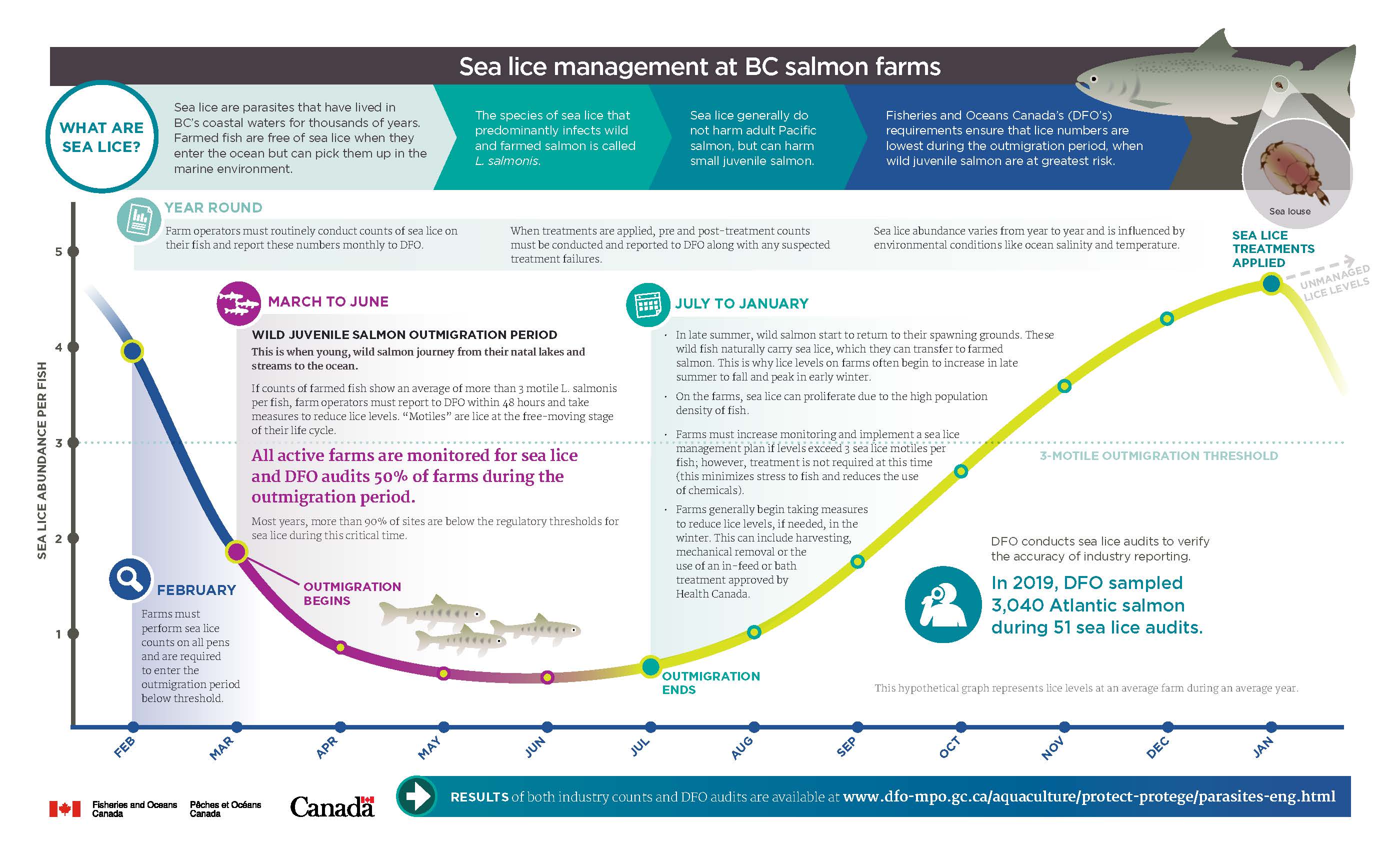Sea lice management at BC salmon farms

Description: Sea lice management at BC salmon farms
What are sea lice?
Sea lice are parasites that have lived in BC's coastal waters for thousands of years. Farmed fish are free of sea lice when they enter the ocean but can pick them up in the marine environment.
The species of sea lice that predominantly infects wild and farmed salmon is called L. salmonis.
Sea lice generally do not harm adult Pacific salmon, but can harm small juvenile salmon.
Fisheries and Oceans Canada's (DFO's) requirements ensure that lice numbers are lowest during the outmigration period, when wild juvenile salmon are at greatest risk.
DFO conducts sea lice audits to verify the accuracy of industry reporting. In 2019, DFO sampled 3,040 Atlantic salmon during 51 sea lice audits.
Results of both industry counts and DFO audits are available at http://www.dfo-mpo.gc.ca/aquaculture/protect-protege/parasites-eng.html.
Year round
Farm operators must routinely conduct counts of sea lice on their fish and report these numbers monthly to DFO.
When treatments are applied, pre and post-treatment counts must be conducted and reported to DFO along with any suspected treatment failures.
Sea lice abundance varies from year to year and is influenced by environmental conditions like ocean salinity and temperature.
February
Farms must perform sea lice counts on all pens and are required to enter the outmigration period below threshold.
March to June
Wild Juvenile Salmon Outmigration Period: This is when young, wild salmon journey from their natal lakes and streams to the ocean.
If counts of farmed fish show an average of more than 3 motile L. salmonis per fish, farm operators must report to DFO within 48 hours and take measures to reduce lice levels. “Motiles” are lice at the free-moving stage of their life cycle.
All active farms are monitored for sea lice and DFO audits 50% of farms during the outmigration period.
Most years, more than 90% of sites are below the regulatory thresholds for sea lice during this critical time.
July to January
In late summer, wild salmon start to return to their spawning grounds. These wild fish naturally carry sea lice, which they can transfer to farmed salmon. This is why lice levels on farms often begin to increase in late summer to fall and peak in early winter.
On the farms, sea lice can proliferate due to the high population density of fish.
Farms must increase monitoring and implement a sea lice management plan if levels exceed 3 sea lice motiles per fish; however, treatment is not required at this time (this minimizes stress to fish and reduces the use of chemicals).
Farms generally begin taking measures to reduce lice levels, if needed, in the winter. This can include harvesting, mechanical removal or the use of an in-feed or bath treatment approved by Health Canada.
Graph
This hypothetical graph represents the sea lice levels at an average farm during an average year.
The x-axis (horizontal) shows each month of the year and the y-axis (vertical) shows numbers, ranging from from 0 to 5, that represent the sea lice abundance per fish. On the y-axis, at 3 sea lice abundance per fish, there is a line across the graph as this represents the 3-motile outmigration threshold.
If the sea lice abundance per fish goes above 5, it is considered an unmanaged lice level.
The sea lice abundance per fish per month is as follows:
- January: 5 - at this level, sea lice treatments are applied
- February: 3.9
- March (Outmigration begins): 1.8
- April: 0.8
- May: 0.7
- June: 0.4
- July (Outmigration ends): 0.6
- August: 1
- September: 1.6
- October: 2.7
- November: 3.6
- December: 4.4
- Date modified: